Categories
- Argentina
- Chile
- Antarctica
- Easter Island
- Falklands (Malvinas)
- Bolivia
- Peru
- Uruguay
- Paraguay
- Brazil
- Venezuela
- Colombia
- Ecuador
- Galapagos
- Panama
- Costa Rica
- Cuba
- Nicaragua
- Honduras
- El Salvador
- Guatemala
- Belize
- Mexico
- Latin American Xmas
Pages
- Map of South America
- Home Page
- First week in Latin America – October 2009
- Map of Central America
- Contact Us
- The Jesuit Missions in South America
- A week in Buenos Aires
- Street Art of Buenos Aires
Archives
- October 2011 (3)
- September 2011 (9)
- August 2011 (10)
- July 2011 (7)
- June 2011 (6)
- May 2011 (11)
- April 2011 (10)
- March 2011 (4)
- February 2011 (5)
- January 2011 (6)
- December 2010 (6)
- November 2010 (4)
- October 2010 (8)
- September 2010 (5)
- August 2010 (7)
- July 2010 (5)
- June 2010 (6)
- May 2010 (6)
- April 2010 (7)
- March 2010 (6)
- February 2010 (9)
- January 2010 (4)
- December 2009 (8)
- November 2009 (5)
- October 2009 (2)
Antigua
21st May 2011
Antigua [2], surrounded by 3 volcanos, Agua, Acatenango and Fuego, was our first stop in Guatemala. Another impressive World Heritage city, Antigua was the Spanish colonial capital of Central America for 231 years. The remains of a dozen or so ornate churches, monasteries and convents destroyed by earthquakes give Antigua an unequalled charm. From our hotel window we had a perfect view of Volcán Agua.
.
Walking around the town we noticed local women in brightly woven cloth skirts and tops. Guatemala has the largest Mayan population of any country. There are at least 15 distinct Mayan groups in the country, speaking Spanish as a second language. The textile museum (Museo Casa del Tejido) provided a fascinating insight into the traditional Maya dress from the highlands. Each village has its own different patterns; married women wear different belts to single women. They wear a beautifully woven folded cloth on their heads for sun protection (hiding the beautiful design). The men also have their distinctive trousers and shirts, with collars to match their wives’ shawls.
.

Volcán Agua from our bedroom window

Twin Volcanoes Acatenango and Fuego

Cathedral in Antigua

Ruins of the Jesuit church

Inner courtyard of the Jesuit church has been restored

Iglesia La Merced

Ladies in traditional dress

Lady selling woven cloth on the street

Lady selling mangoes outside a church

Iglesia Santo Hermano Pedro has been caring for the disabled for 350 years

Entrance to the University San Carlos (1675)

Cobbled street

All the houses have chimneys

Street vendors cart

Iglesia San Francisco

Inside is a painting depicting the Maya

Other church ruins

Other church ruins

The old laundry
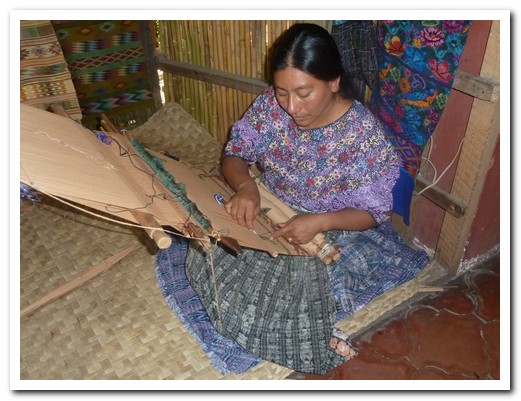
A lady weaving the traditional way

Example of traditional clothing

Another example of traditional clothing

Convento de Santa Catalina (1613)
Lago de Atitlán
25th May 2011
Panajachel [3] (or Pana as the locals call it) on Lake Atitlán at 1500 metres made a good base to explore the villages scattered around the lake. We enjoyed our stay at the Posada de los Volcanes hotel. For Mayans “Atitlan” means “the place where the rainbow gets its colours” and it is a beautiful place. On a clear day 3 magnificent volcanos, San Pedro, Tolimán and Atitlán can be seen towering over the lake. The village is all about tourism, shops and stalls full of all sorts of colourful souvenirs line the streets – the main street is 10 “no gracias” long.
.
Sunday is market day at Santiago Atitlán on the other side of the lake. By the time we arrived on the chicken boat the village was bustling with men, women and children, most dressed in traditional attire unique to the village. The men wear knee length woven cotton pants, some with stripes, others with an intricately embroidered pattern around the bottom, an embroidered sash, long sleeve shirt and finished off with a cowboy hat. The women´s blouses have an exquisite embroidered pattern such as birds or flowers around the neck. They wear these with a bright woven, wrap around skirt, tied up with an embroidered sash with a colourful shawl over the shoulder. We sat and listened to the melodious sounds of hymns coming from the overflowing 1547 church just off the main square.
.
On Monday we went by boat, which only goes when it is full, to the villages of San Pedro La Laguna and San Marcos La Laguna. San Pedro sits below the volcano of the same name. Both villages have significant populations of feral gringos and instead of beauty and tranquillity had a creepy feel. The women of San Pedro wear lovely coordinated blouses, skirts and aprons, quite different to Santiago just a few kilometres away.
.
Carlos, we called him Caro (expensive) because he charged gringo prices, took us in his tuk tuk to the lakeside villages of Santa Catarina Palopó and San Antonio Palopó. The women of both villages weave and wear brilliant blue – the colour of the lake.
.

Volcán Tolimán with Volcán Atitlán behind

Fishing on the lake

1547 Church at Santiago de Atitlán overflowing with worshipers

Carved saint re-dressed by local women each year

Women at Santiago market

Men discussing knives for sale at the Santiago market

Children on the Santiago church steps

Family in their Sunday best

Beautiful embroidery on the blouse favoured by the women of Santiago

Hat made from 30 meters of embroidered ribbon wound round and round

Santiago man´s embroidered trousers

We liked these colourful parrots, so we bought this piece

Panajachel lakeside restaurant

Volcán San Pedro

Market at San Pedro la Laguna

Ladies bargaining at San Pedro market - they all wear aprons here

Old man climbing up from the lake
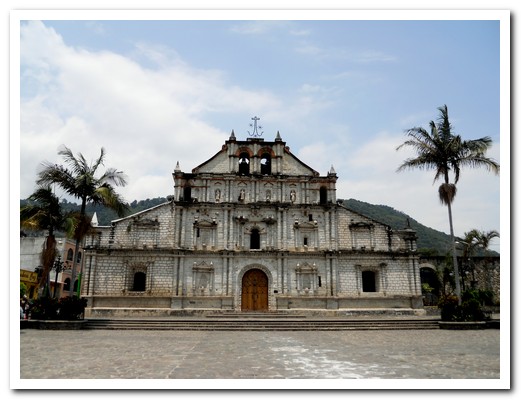
1541 Cathedral at Panajachel has the original facade

Carlos took us in his tuk tuk

Church at Santa Catarina Palopó

Lady weaving - Santa Catarina

Typical blue, the colour of the lake, worn by ladies in Santa Catarina

Santa Catarina cemetery matches the colours of the dresses

The village of San Antonio Palopó on the lake shores

Women in San Antonio Palopó wear a thin headband

Typical dress from San Antonio Palopó

Shorts worn by the men of San Antonio Palopó

Sololá man (from 500 meters higher up) makes a sale in Pana
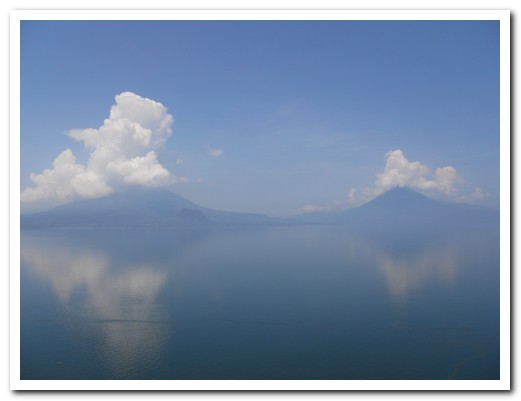
Looking across the lake at the volcanoes
Chichicastenango
26th May 2011
After transferring to Chichicastenango (Chichi) [4] in the Guatemalan highlands, we headed down to the main square to match the people setting up their stalls for the market the following day. Amidst the hectic scene people were cooking tortillas, corn and fried chicken. Next to the Market is the church of Santo Tomás (1540), built on top of a Mayan temple. 18 steps, one for each month in the Mayan calendar, lead up to the church. The evening before market, incense and candles are burnt on the church steps to pray for good sales.
.
People from the surrounding villages have been bringing their goods here to sell since before the Spanish. Arriving early on market day, we sat high on the church steps among the flower sellers to watch the vibrant movement of people. A stall could be as simple as a basket of berries on the street, a bucket of chillies or corn from the sack to expensive jewellery. As well as the quality handicrafts there is pottery, household goods, fruit and vegetables, wooden masks, chickens, fragrant wood and much more. Offerings were burnt in front of the church in an age old Mayan ritual, more incense was spread about which filled the church before the arrival of 2 Cofradias (Mayan priests). There is an acceptance of Mayan beliefs, and a strange mix of Catholicism and Mayan rites.
.
The ladies´ blouses here remind us of an old fashioned tapestry wall hanging. The hand embroidered patterns on top of an already heavy woven material cover almost the entire blouse. At 2000 meters up, it can get cold in Chichi. Yet the skirts go only just below the knees, in contrast to the women of Lake Atitlán who wear theirs down to their ankles.
.

1540 Santo Tomás Church in the centre of Chichi

Market stalls being set up the night before

Flower sellers on the Church steps
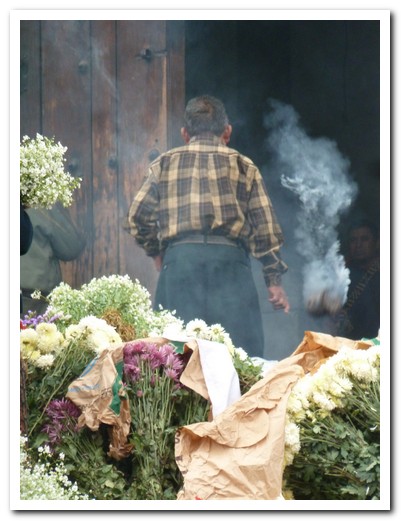
Incense being spread around outside the Church

Offerings burnt at the bottom of the steps to the Church

Mayan priests on their way to the Church

Kneeling in front of the Church

A simple stall

Pottery

Turkey anyone?
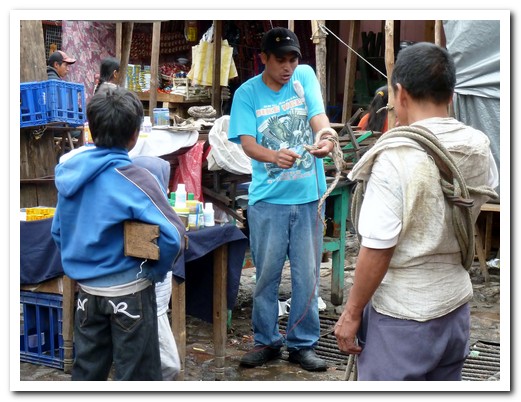
Every market needs a snake oil man

Stacks of colourful hand woven cloth

Corn is sold from the sack

Flower seller

Typical dress

People standing around the market

Little old lady with her flowers
 |
 |
| Chichi is a famous for ceremonial mask carving |

Blue tortillas, made from blue corn, cooking at the market
Quetzaltenango
29th May 2011
Further west, Quetzaltenango (Xela) [5] sits higher up at 2300 meters. Outside the city in fertile valleys backed by mist covered mountains, a patchwork of farms grow a variety of crops without the use of machinery. Bananas shade coffee grown up the slopes. In the village of Zunil the women´s skirts are particularly attractive.
.
With Eddie as our guide we headed off to the jungle surrounded archaeological site of Takalik Abaj, about 2 hours southwest of Xela, where evidence of both Olmec (the earliest Mesoamerican civilization) and early Maya has been unearthed. Work is still going on at the site and a large pyramid structure is being reconstructed but much of the site remains buried.
.
In the afternoon we went to see some nearby villages with quaint and unusual churches. The magnificent 1524 church at Salcajá, Hermita la Concepción, is the oldest in Central America. We also visited a house next to the church where we sampled a very smooth homemade rum and fruit liqueur (called caldo de frutas) made only in Salcajá and watched a man weaving skirt material on a Spanish loom (the women weave narrower pieces on a pre-Spanish back strap loom).
.
The large white church, some 250 to 300 years old, in San Cristobál Totonicapan is dedicated to Santiago the Apostle. Moving on to San Andrés Xecul with its bright yellow church bearing vividly coloured figures, Eddie took us to the house just up the hill where San Simón resides – a mix of Mayan and Christian influences. People arrived with offerings of cigarettes and alcohol, then lit candles (different colours for each day to overcome various ailments and punish enemies) while praying to this bizarrely dressed, hard drinking, chain smoking, and fornicating figure – not the sort of Saint you´d want to upset!
.
Due to recent violent activity and Travel Advise against going to the north of the country, as well as a scew up with our visas way back in Honduras, we limited our time to southern highlands, unfortunately missing the World Heritage Mayan ruins of Tikal and will fly out of Guatemala City [6] for Belize.
.

Facade and bell tower of the old Cathedral in Xela

Cathedral domes at night
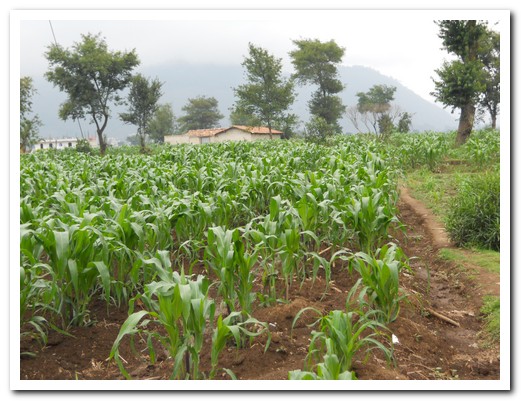
Corn is the staple crop in the highlands

Ladies skirts ....

... are very colourful in Zunil

Picking onions near Zunil

Coffee grows on the slopes

Smoking Volcán Santiaguito

Early Mayan pyramid at Takalik Abaj

Another pyramid
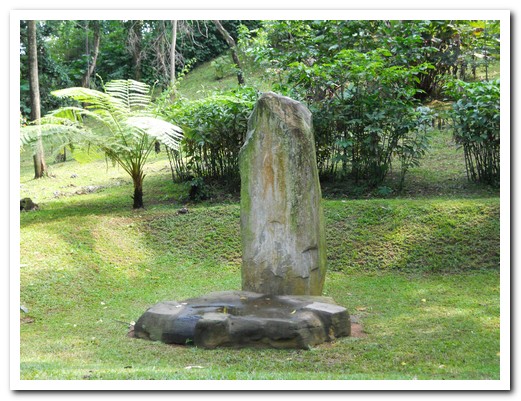
Stela with altar in front

Large Olmec head, about 1 metre high

Statues in front of steps
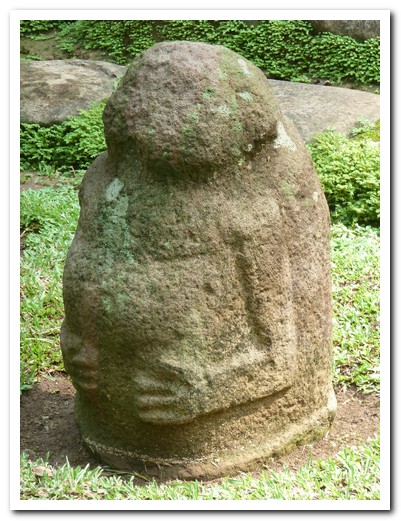
Potbellied Olmec statue

Two more Olmec statues

Large toad

Olmec head - with a cross legged person coming out of the mouth

Hieroglyphics
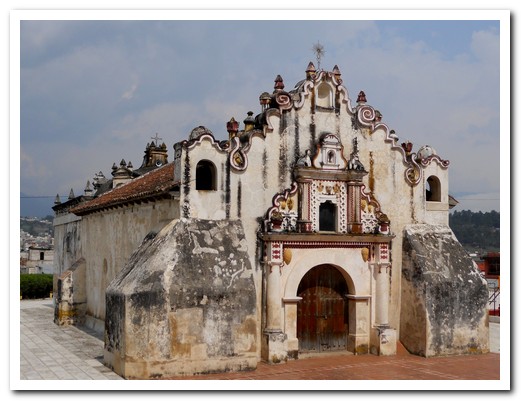
Oldest church in Central America (1524)

Homemade liqueur (caldo de frutas), the fruit is delicious too
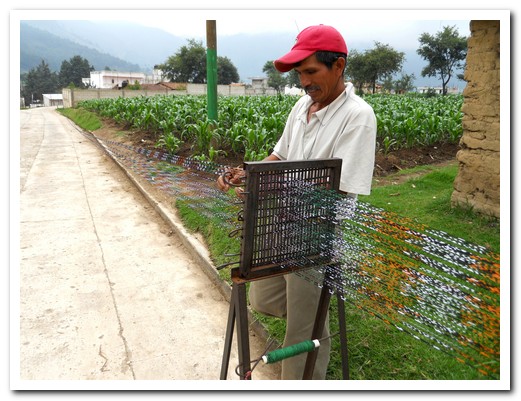
Preparing the cotton thread for a 150 metre long cloth
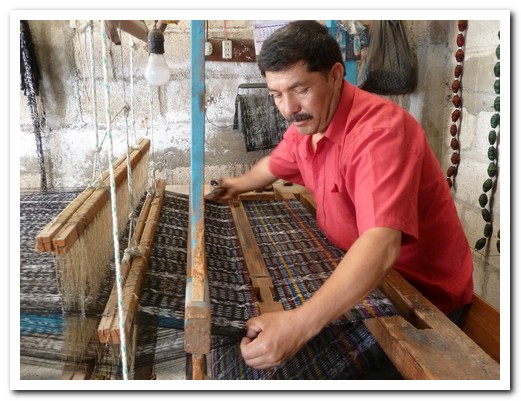
Men weave on the Spanish foot loom

The finished cloth sells for about $4 a metre, not much return for the work

Church at San Cristobal Totonicapán is about 300 years old

Convent behind the church

Ladies chatting

Coming home from shopping

Bright yellow 17 the century church at San Andrés Xecul

San Simón, the hard drinking, smoking Mayan saint